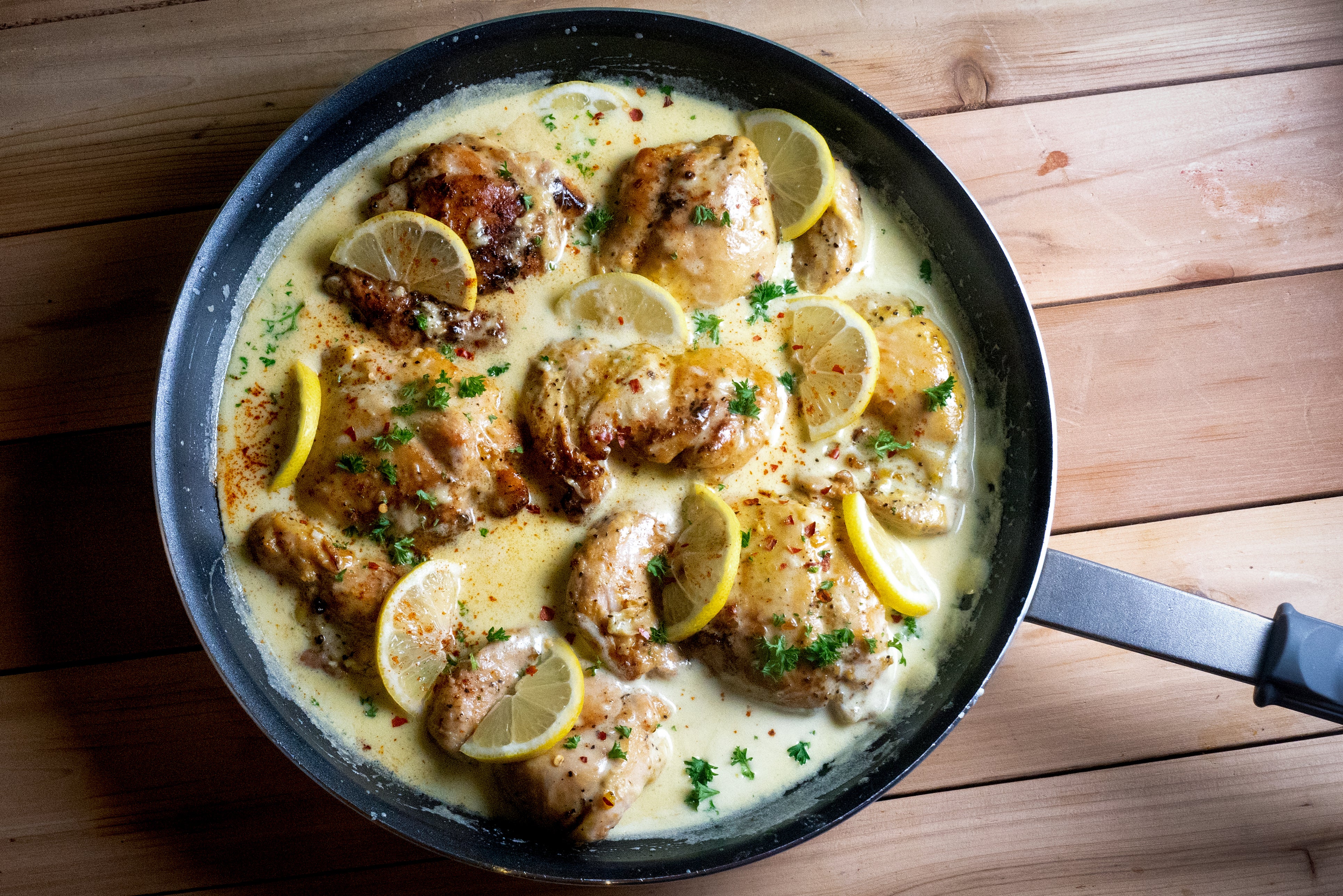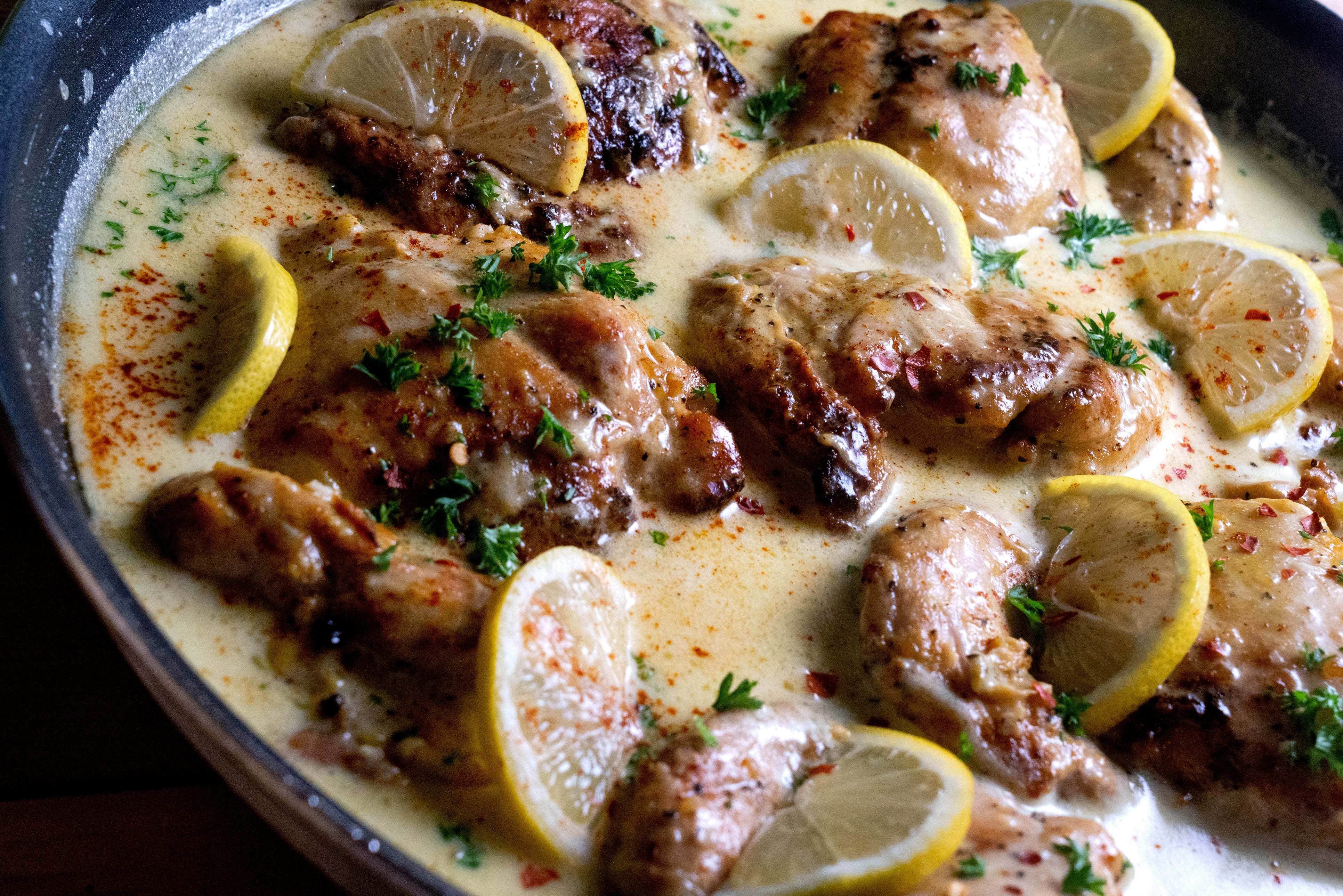The Independent's journalism is supported by our readers. When you purchase through links on our site, we may earn commission.
Ottolenghi’s lemon chicken recipe examines the global allure of crispy chicken
For those who eat meat, chicken is accessible and approachable to cook in a way that red meat isn’t always. Here’s my Middle Eastern inspired take on lemon chicken, writes Yotam Ottolenghi

Your support helps us to tell the story
From reproductive rights to climate change to Big Tech, The Independent is on the ground when the story is developing. Whether it's investigating the financials of Elon Musk's pro-Trump PAC or producing our latest documentary, 'The A Word', which shines a light on the American women fighting for reproductive rights, we know how important it is to parse out the facts from the messaging.
At such a critical moment in US history, we need reporters on the ground. Your donation allows us to keep sending journalists to speak to both sides of the story.
The Independent is trusted by Americans across the entire political spectrum. And unlike many other quality news outlets, we choose not to lock Americans out of our reporting and analysis with paywalls. We believe quality journalism should be available to everyone, paid for by those who can afford it.
Your support makes all the difference.Fried chicken, crispy chicken, chicken schnitzel: Is there another dish so ubiquitous and yet, so particular? Everyone has one, yes, but everyone has their own. An “Around the World in 80 Dishes” cookbook could easily be filled with nothing but fried chicken recipes: Austrian schnitzel, Korean fried chicken, Italian pollo fritto, Japanese tonkatsu, chicken Milanese, Chinese gong bao, Senegalese chicken yassa, Southern fried chicken and so on. Fried chicken is beloved globally.
It’s easy to understand why. Chicken is, for those who eat meat, accessible and approachable to cook and consume in a way that red meat isn’t always. It’s uncomplicated, often quick and, crucially, ticks the “What will everyone around the table eat?” box. And that’s all before it’s even fried.
In the world of things that can be marinated, coated and fried, chicken is hard to beat. Once crispy and tender, chicken is the dish holding so many events together. Whether it’s a plate passed around a small family supper or a platter slid across the pass of a restaurant chain chances are there’s chicken on it.
Behind every fried or crispy chicken recipe is a story. Books are dedicated to tracing the roots and politics of Southern fried chicken, the role slavery played in its history and the racist stereotypes that accompanied it.
The name of a chicken dish can change and, in so doing, say much about the time it came from. That was the case with gong bao ji ding, the Chinese chicken dish with peanuts, named after the late-19th century governor of Sichuan, Ding Baozhen, whose official title was Gongbao. His association with the dish led Cultural Revolution radicals to change the name of the dish to hong bao ji ding — fast-fried chicken cubes. It stayed that way until the 1980s.
Or the story can be one of movement, the journey a dish goes on within just one family, where the same secret recipe is guarded and passed down from one generation to the next. History and politics, time and place: These are all big stories in which fried chicken plays a small but real role.
This Middle Eastern version uses a cheater’s preserved lemon paste and plenty of fresh lemon to brighten it up
Rather prosaically, the story also can be of what is on the shelf and in the cupboards that needs eating on a weeknight. This is certainly the case for me when I cook crispy chicken at home. Central European immigrants who came to Israel during the 20th century turned the chicken schnitzel into a standard weeknight fare in most Israeli homes. The schnitzel (and an almost mandatory chopped salad and bowl of fries) that was served nearly every time I stayed for dinner at a friend’s house is what springs to mind when I open the fridge and cupboard in preparation for supper.
And then there are the stories and memories of fried chicken eaten with friends and strangers on my travels through Asia and back home in London — including the westernised Chinese lemon chicken I often loosely base my own version on.
Along with those memories, I have the ingredients that take up permanent residence on my shelves, which I reach for whenever I cook: fresh and preserved lemon, cumin seeds and cilantro, butter and broth, soy sauce and eggs. The result is a fast-food supper with a long, rich history: delicious enough to keep my kids at the table for long enough that I might actually get around to telling them some of the stories.
And to Drink …
With this recipe’s obvious resemblance to chicken schnitzel, I thought of the usual accompaniments to schnitzel dishes in Austria: gruner veltliner or dry riesling. The gruner will most likely be Austrian, though I’ve had a few good versions from California. The dry riesling could come from anywhere. A rich Wachau from Austria would be excellent, as would a grosses gewachs from Germany or a grand cru from Alsace. While you’re at it, check out some of the better bottles from the Finger Lakes or Australia. Other options? A richer Sancerre would be great. So would a Chablis, maybe a Soave from the Veneto region of Italy or an assyrtiko from Santorini. I would not choose a red with this dish, but I would not hesitate to open a bottle of Champagne. — Eric Asimov
Double lemon chicken

The universally loved crispy chicken — from Austrian schnitzel to Korean fried chicken to the westernised lemon chicken that you’d get at your local Chinese restaurants — is found in multiple corners of the world, and is therefore served on many tables. That lemon chicken is the inspiration for this dish, where a sweet lemony sauce coats crispy fried chicken pieces. This Middle Eastern version uses a cheater’s preserved lemon paste and plenty of fresh lemon to brighten it up. You’ll make a little more preserved lemon paste than you need; use it for salad dressing, toss it with roasted vegetables, or swirl it into soups. Serve this dish with some lightly cooked greens and plain white rice.
Serves: 4 servings
Time: 1 hour 15 minutes
For the chicken:
2 medium egg whites (About 60g) (save the yolks for another use)
2 tablespoons soy sauce
2 tablespoons cornstarch (cornflour)
Salt and black pepper
4 large boneless, skinless chicken breasts
80ml neutral oil, such as sunflower oil
1 spring onion, trimmed and finely sliced at an angle
1 tablespoon (about 5g) roughly chopped cilantro (coriander) leaves
2 tablespoons lemon juice (from 1 to 2 lemons)
For the cheater’s preserved lemon paste:
1 large unwaxed (or well-scrubbed) lemon (about 150g), ends trimmed and discarded, then cut into 1/2cm-thick rounds, seeds (pips) removed
60ml lemon juice (from 2 lemons)
2 teaspoons flaky sea salt
For the lemon sauce:
700ml chicken stock
1 1/2 tablespoons/25 grams unsalted butter
2 garlic cloves, peeled and minced
1 tablespoon superfine sugar (caster sugar), or granulated sugar
1/8 teaspoon ground turmeric
1 1/2 teaspoons cumin seeds, toasted and roughly crushed in a mortar and pestle
1 1/2 tablespoons cornstarch (cornflour)
2 tablespoons lemon juice (from 1 to 2 lemons)
Salt and black pepper
Method
1. Prepare the chicken: In a large bowl, whisk together the egg whites, soy sauce, cornflour, 1/2 teaspoon salt and a good grind of pepper just until there aren’t any lumps, about 30 seconds. Working one breast at a time, place the chicken between 2 pieces of parchment paper and use a meat mallet (or the bottom of a pan) to pound the chicken evenly so it’s a scant 1cm thick. Transfer to the egg white bowl and continue with the remaining. Stir everything together gently to coat, and refrigerate to marinate for at least an hour (or overnight if you’re getting ahead).
2. Meanwhile make the preserved lemon paste: Add all the ingredients to a small, lidded saucepan set over medium-high heat. Bring to a simmer, then lower the heat to medium-low, cover and cook for 12 to 14 minutes, or until the rinds start to look translucent and the juice has reduced by about half. Set aside to cool slightly, then transfer everything to a small food processor and blitz until you have a smooth, spreadable paste. (You should have about 1/4 cup.) Set aside 3 tablespoons for the sauce, then store the rest in a sealed container in the fridge for up to 4 weeks.
3. Make the sauce: Add the 3 tablespoons preserved lemon paste, the stock, butter, garlic, sugar, turmeric and half the cumin to a medium saucepan, then place it over medium-high heat. Bring to a boil, then cook, stirring occasionally, for 15 minutes, until reduced by about a third. Measure out roughly 3 tablespoons of the sauce into a small bowl, then add the cornflour and whisk until there are no lumps. Whisk this back into the sauce pot and cook for 1 minute, whisking continuously, until smooth and thickened slightly. Remove from the heat.
4. Heat the oil in a large high-sided frying pan over a medium-high heat. Once hot (a sprinkle of cornstarch dropped into the oil should sizzle right away), fry two of the chicken breasts for 3 minutes per side, or until nicely browned and just cooked through. It should release easily from the skillet with a little help from a metal spatula. Transfer to a paper towel-lined plate and continue with the remaining 2 breasts. It might spit, so turn down the heat if needed. Wipe out the frying pan, add the sauce and bring to a simmer over medium-high heat. Add back all the chicken breasts and cook for just 3 minutes, gently turning them halfway. Remove from the heat and stir in the 2 tablespoons of lemon juice.
5. Transfer the chicken breasts (cut them into strips, if you like) to a large serving platter with a lip and pour the sauce all over. Sprinkle with the remaining cumin. In a small bowl, toss together the spring onion, cilantro and remaining 2 tablespoons of lemon juice, and spoon this all over.
This article originally appeared in The New York Times.



Join our commenting forum
Join thought-provoking conversations, follow other Independent readers and see their replies
Comments